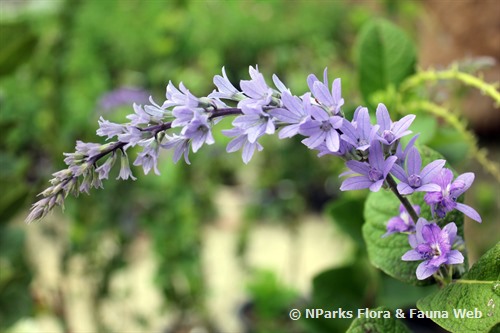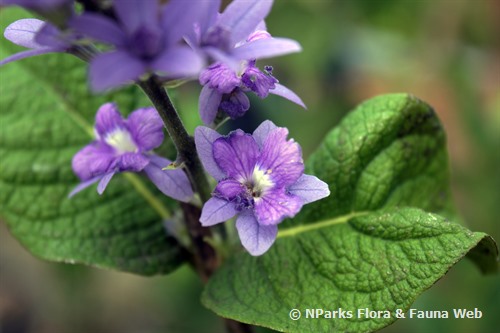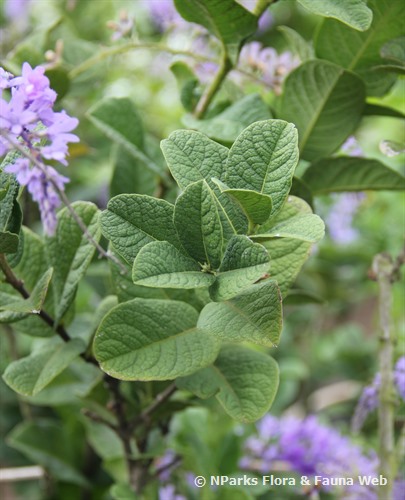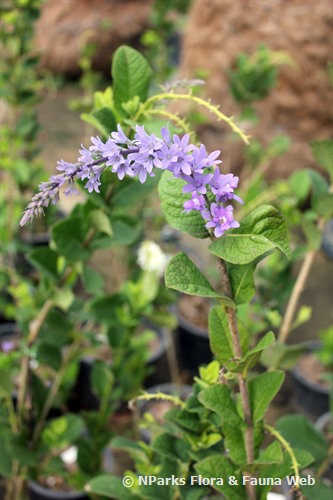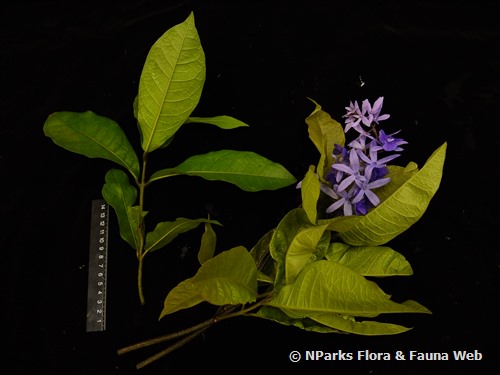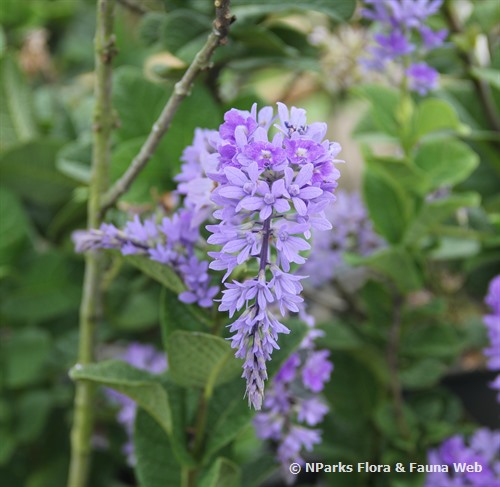
Back
Petrea rugosa Kunth
| Family Name: | Verbenaceae |
| Synonyms: | Petrea obtusifolia, Petrea rugosa f. casta, Petrea rugosa f. casta |
Petrea rugosa is an evergreen shrub with attractive rough-textured, dark green leaves. It thrives well in warm environments, adorning gardens with cascades of vibrant bluish purple flowers resembling wisteria.
Name
Classifications and Characteristics
| Plant Division | Angiosperms (Flowering Seed Plants) (Dicotyledon) |
|---|---|
| Plant Growth Form | Shrub |
| Lifespan (in Singapore) | Perennial |
| Mode of Nutrition | Autotrophic |
| Maximum Height | 3 m |
Biogeography
| Native Distribution | Colombia, Panamá, Venezuela |
|---|---|
| Native Habitat | Terrestrial |
| Local Conservation Status | Non-native (Horticultural / Cultivated Only) |
Description and Ethnobotany
| Growth Form | Shrub that grows to about 3 m tall. |
|---|---|
| Foliage | Leaves measuring 3 - 10 x 2.5 - 7 cm, elliptical to oblong shaped, pubescent on the underside of leaves, rough texture on both surfaces, dented at maturity. Leaf base obtuse to truncate, apex obtuse to emarginate, and margin entire. Petioles measuring 1- 6 mm long and pubescent. |
| Stems | Stems have quadrangular and pubescent branches. |
| Flowers | Inflorescence measuring 12 - 50 cm long, usually axillary and solitary along the stem. Pedicels are pubescent, calyx is about 6 mm and slightly pubescent, lobes are 10 - 13 mm long. Corolla is 8 - 11 mm long, slightly hairy, blue or white, 5 broadly elliptical lobes. The calyx persists on the plant after the flowers have dropped. |
| Habitat | Found in low deciduous forests and river banks. |
| Etymology | The genus Petrea is named after Robert James Petre, the patron of botany. The specific epithet rugosa means wrinkled, rugose, in reference to the leaf surface. |
Landscaping Features
| Desirable Plant Features | Ornamental Flowers, Ornamental Foliage |
|---|---|
| Landscape Uses | Parks & Gardens |
Plant Care and Propagation
| Light Preference | Full Sun |
|---|---|
| Water Preference | Moderate Water |
| Plant Growth Rate | Moderate |
| Rootzone Tolerance | Well-Drained Soils, Moist Soils, Fertile Loamy Soils |
| Propagation Method | Stem Cutting |
Foliar
| Foliage Retention | Evergreen |
|---|---|
| Mature Foliage Colour(s) | Green |
| Mature Foliage Texture(s) | Rough |
| Prominent Young Flush Colour(s) | Green |
| Young Flush Texture(s) | Rough |
| Foliar Type | Simple / Unifoliate |
| Foliar Arrangement Along Stem | Opposite |
| Foliar Attachment to Stem | Petiolate |
| Foliar Shape(s) | Non-Palm Foliage (Elliptical, Oblong) |
| Foliar Venation | Pinnate / Net |
| Foliar Margin | Entire |
| Foliar Apex - Tip | Emarginate, Obtuse |
| Foliar Base | Rounded / Obtuse, Truncate / Square |
Non - Foliar and Storage
| Stem Type & Modification | Woody |
|---|---|
| Root Type | Underground |
Floral (Angiosperm)
| Flower & Plant Sexuality | Bisexual Flowers |
| Flower Colour(s) | Purple, Blue |
|---|---|
| Flower Texture(s) | Smooth |
| Flower Grouping | Cluster / Inflorescence |
| Flower Location | Axillary |
| Flower Symmetry | Radial |
| Individual Flower Shape | Stellate / Star-shaped |
| Inflorescence Type | Raceme |
| Flowering Period | Free-Flowering |
References
| References | <1> Davidse, G. & al. (eds.) (2012). Flora Mesoamericana 4(2): 1-533. Universidad Nacional Autónoma de México, México, D.F. |
|---|
Image Repository
Others
| Master ID | 33120 |
|---|---|
| Species ID | 7534 |
| Flora Disclaimer | The information in this website has been compiled from reliable sources, such as reference works on medicinal plants. It is not a substitute for medical advice or treatment and NParks does not purport to provide any medical advice. Readers should always consult his/her physician before using or consuming a plant for medicinal purposes. |

